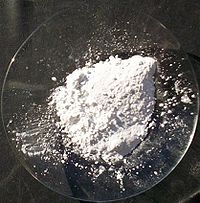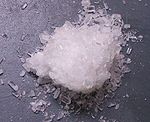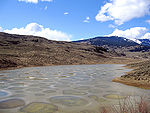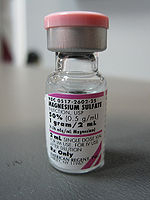| Magnesium sulfate |
 |
| General |
| Systematic name |
Magnesium sulfate |
| Other names |
Epsom salt and or Bitter salts |
| Molecular formula |
MgSO4 |
| SMILES |
[Mg++].[O-]S([O-])(=O)=O |
| Molar mass |
[[Molar mass::120.366 g/mol (anhydrous)
246.47 g/mol (heptahydrate)]] |
| Appearance |
white crystalline solid |
| CAS number |
7487-88-9 |
| Properties |
| Density and phase |
[[Density::2.66 g/cm3 (anhydrous)
2.445 g/cm3 (monohydrate)
1.68 g/cm3 (heptahydrate)
1.512 g/cm3 (11-hydrate) g/ml]] |
| Solubility in water |
anhydrous
269 g/L (0 °C)
255 g/L (20 °C)
heptahydrate
710 g/L (20 °C) g/100 ml (?°C) |
| Melting point |
[[Melting point::1124 °C (anhydrous, decomp)
200 °C (monohydrate, decomp)
150 °C (heptahydrate, decomp)
2 °C (11-hydrate, decomp)]] |
| Boiling point |
Boiling point::?°C |
| Acidity (pKa) |
? |
| Basicity (pKb) |
? |
| Chiral rotation [α]D |
?° |
| Viscosity |
? cP at ?°C |
| Structure |
| Molecular shape |
? |
Coordination
geometry |
? |
| Crystal structure |
? |
| Dipole moment |
? D |
| Hazards |
| MSDS |
Material safety data sheet |
| Main hazards |
? |
| NFPA 704 |
|
| Flash point |
?°C |
| R/S statement |
R: ?
S: ? |
| RTECS number |
? |
| Supplementary data page |
Structure and
properties |
n, εr, etc. |
Thermodynamic
data |
Phase behaviour
Solid, liquid, gas |
| Spectral data |
UV, IR, NMR, MS |
| Related compounds |
| Other anions |
? |
| Other cations |
? |
| Related ? |
? |
| Related compounds |
? |
Except where noted otherwise, data are given for
materials in their standard state (at 25 °C, 100 kPa)
Disclaimer and references |
Magnesium sulfate, or Magnesium sulphate, is classified as an Epsom salt or a bitter salt. Magnesium sulfate is a chemical compound that contains three elements that include Oxygen, Sulfur and Magnesium. Magnesium sulfate's has the molecular formula of MgSO4. [1] Magnesium sulfate could arguably be said to be discovered by Doctor Nehemiah Grew. In southern England in the seventeenth century, it is said that Magnesium sulfate known as Epsom was found in spas were people would go to take water that had medicinal value. Doctor Nehemiah Grew made chemical analysis of the Epsom salt in the spa's and found Magnesium sulphate.[2]
Physical Properties

Magnesium Sulfate contains needle like structures that surround it.
Magnesium sulfate is a white crystalline solid but is to a certain extent without color and odor. Being a salt Magnesium sulfate is known to have quite a bitter taste to it. Magnesium sulfate altogether has a very high solubility especially in water, water is considered an inorganic solvent. An example of Magnesium sulfates solubility can be shown in an example of placing 700 grams of magnesium at room temperature in one liter of water. The magnesium will dissolve right through the liter of water. In sea water Magnesium sulfate plays an important role of the absorption of sound in water through the conversion of acoustic energy into heat energy. Sound and high frequencies are affected by magnesium sulfates main role in sea water. Magnesium sulfate can be applied into organic synthesis as a drying agent, because of its propensity to gather moisture from the air. [3]
Chemical Properties
Magnesium sulfate can be found in a variety of Hydrates which is basically a substance containing water. Some Hydrates that Magnesium sulfate may be found in are heptahydride,hexahydrate, pentahydrate, sanderite and mainly in Kieserite. Magnesium sulfate's reaction with water can be seen when it is dissolved, when this occurs it separates into ions of both sulfate and magnesium. [4]
Occurrences

A lake with high mineral concentrations including magnesium sulfate.
Magnesium sulfate can be found in more than 95 percent of mineral waters which is quite amazing considering that it is a salt. Magnesium sulfate is known to be about 2 percent of the known unrefined ocean sea salt. The human body is also home to Magnesium sulfate; it is a fact that the human body indeed needs magnesium sulfate. [5] Magnesium sulfate, as stated previously, is a mineral that is commonly found in mineral waters. Magnesium sulfate is also found in geological environments. The occurrence of magnesium sulfate is associated with the supergene process which is the predominance of meteoric water and the loss of electrons through the circulation of the oxidation. [6]
Uses

Magnesium Sulfate preparation for an experiment.
Magnesium sulfate has quite an abundant amount of helpful uses. Some uses of Magnesium sulfate may include, but are not limited to, the treatment of pre-eclampsia, eclampsia and preterm labor. Eclampsia is basically a term for convulsions or coma during or right after pregnancy. Preterm labor is basically labor that begins before the completion of the 37th week of pregnancy. Preterm Labor can put the baby at risk for health deficiencies. One must firstly understand why Magnesium sulfate is used concerning pre-eclampsia and eclampsia. In order to prevent pre-eclampsia from becoming full blown eclampsia, which are convulsions that can be life threatening, Magnesium sulfate is used as a drug. Magnesium sulfate can be given to patients in the hospital through an IV and in some cases shots may be applicable to patients. A woman that is having convulsions from eclampsia may be given a single dose of magnesium sulfate containing 4 to 6 grams. Magnesium sulfate can be used to treat pre-eclampsia and eclampsia for short periods at a time two days at the most or until the child is born. The only true cure for pre-eclampsia is in fact the birth of the child, the drugs cease being used after the child is born. A woman is given magnesium sulfate for preterm labor as a drug because doctors believe that magnesium sulfate relaxes the muscles and uterus. In treating preterm labor magnesium sulfate is in fact not FDA approved. Like the drug that is used for pre-eclampsia and eclampsia the drug for preterm labor can be administered in the hospital through an IV and can sometimes be administerd through shots. The dosages that are administered vary depending on the woman and how long she has been in labor. It is probable that a woman in preterm labor will receive 4 to 6 grams of dosage through an IV in the hospital. [7]
Health Effects and First Aid Measures
In order to be prepared to handle Magnesium Sulfate one must first wear Lab protective equipment. For Magnesium Sulfate the protective equipment may consist of Goggles, a Lab coat, Vent hood, and proper gloves. Some health hazards may consist of Inhalation, Ingestion, skin contact, eye contact, chronic exposure, and Aggravation of Pre-existing Conditions. If Magnesium sulfate is inhaled one may experience coughing and or a sore throat. If inhaled one must move to an area where fresh air is available and if one is having trouble breathing medical attention must be first priority to the individual. If Magnesium sulfate is ingested the most common signs would be diarrhea, vomiting, and abdominal pain due to the fact that magnesium salts are absorbed slowly. Some rare symptoms of ingestion may consist of lack of reflexes, hypoglycemia, and depression but are rare in these situations. If the skin comes in contact with the Magnesium sulfate one must remove all contaminated clothing and wash the skin thoroughly with water and soap for at least 10 to 15 minutes. If irritation persists on account of contact to the skin one must immediately seek for medical attention. If the eyes come in contact with the Magnesium sulfate one must wash there face with water thoroughly and seek medical attention if irritation continues. [8]
Handling/Storage and Exposure Controls/Personnel Protection
In order to keep Magnesium sulfate from exposure one must store it in a tightly closed container in an area that is dry, cool and ventilated. One must take in mind that containers of Magnesium sulfate are hazardous when empty because they contain residue such as dust and solids. To avoid exposure through ventilation one can buy a system from a local or general manufacturer. For personal protection for exposure through ventilation one can buy a respirator preferably a NIOSH type N95 which is well known to do a good job. For personnel skin protection one must always wear protective gloves and appropriate clothing that covers the person. For personnel eye protection one needs to use chemical safety goggles and have an eye wash fountain near by at all times. [9]
Video
A brief summary of what Magnesium sulfate is (also known as Epsom Salt)
References
- ↑ Magnesium sulfate Source is Wikipedia, accessed May 23, 2011.
- ↑ Magnesium Sulfate :: history Sakula Alex, Bio Info Bank Library, accessed May 23,2011.
- ↑ Properties of Magnesium Sulfate Bidisha Mukherjee, Buzzle.com, accessed May 18, 2011.
- ↑ Properties of Magnesium Sulfate Bidisha Mukherjee, Buzzle.com, accessed May 18, 2011.
- ↑ SCIENCE: EPSOM SALTS? What are Epsom Salts ? Magnesium Sulfate Heptahydrate? username: confused, cure-zone.com, 3/9/2002 2:00:04 PM.
- ↑ What is Magnesium Sulfate? accessed May 05, 2011
- ↑ Magnesium Sulfate FAQ Mary Foley, Last modified: 11/12/2003 19:11:36 .
- ↑ MAGNESIUM SULFATE J.T.Baker, MSDS, May 5,2011.
- ↑ MAGNESIUM SULFATE J.T.Baker, MSDS, May 5,2011.





